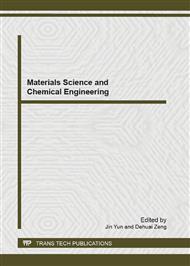[1]
Maria-Ioanna Salaha, Stamatina Kallithraka,Ioannis Marmaras,et al. A natural alternative to sulphur dioxide for red wine production: Influence oncolour, antioxidant activity and anthocyanin content[J], Journal of Food Composition and Analysis, 2008, 21, P660– 666
DOI: 10.1016/j.jfca.2008.03.010
Google Scholar
[2]
Alonso, A.M., Dominguez, C., Dominico, A., Guille'n Barroso, C.G., Determination of antioxidant power of red and white wines by a new electrochemical method and its correlation with polyphenolic content[J], Journal of Agricultural and Food Chemistry 2002, 50, P3112–3115.
DOI: 10.1021/jf0116101
Google Scholar
[3]
Arnous, A., Makris, D.P., Kefalas, P.,. Effect of principal polyphenolic components in relation to antioxidant characteristics of aged red wines[J], Journal of Agricultural and Food Chemistry, 2001, 49, P5736–5742.
DOI: 10.1021/jf010827s
Google Scholar
[4]
Du Toit, M., Pretorius, I.S., Microbial spoilage and preservation of wine: using weapons from nature's own arsenal-a review[J], South African Journal of Enology and Viticulture, 2000, 21, P74–96.
DOI: 10.21548/21-1-3559
Google Scholar
[5]
Plumridge, A., Hesse, S. J. A., Watson, A. J., Lowe, K. C., Stratford, M., & Archer, D. B. The weak acid preservative sorbic acid inhibits conidial germination and mycelia growth of Apergillis niger through intracellular acidification[J], Applied Environmental Microbiology, 2004 70, P3506–3511.
DOI: 10.1128/aem.70.6.3506-3511.2004
Google Scholar
[6]
De Revel, G., Bloem, A., Augustin, M., Lonvaud-Funel, A., & Bertrand, A.. Interaction of Oenococcus oeni and oak wood compounds[J]. Food Microbiology, 2005,22, P569–575.
DOI: 10.1016/j.fm.2004.11.006
Google Scholar
[7]
Threlfall, R. T., & Morris, J. R., Using dimethyldicarbonate to minimize sulfur dioxide for prevention of fermentation from excessive yeast contamination on juice and semi-sweet wine[J], Journal of Food Science, 2002, 67, P2752–2758.
DOI: 10.1111/j.1365-2621.2002.tb08811.x
Google Scholar
[8]
Divol, B., Strehaiano, P., & Lonvaud-Funel, Effectiveness of dimethylcarbonate to stop alcoholic fermentation[J], Food Microbiology, 2005, 22, P169–178.
DOI: 10.1016/j.fm.2004.07.003
Google Scholar
[9]
Kubo,I.,Lee S.H.and Ha,T.J. Effect of EDTA alone and in combination with polygodial on the growth of Saccharomyces cerevisiae[J], Journal of Agricultural and Food Chemistry, 2005, 53(5), P1818-1822.
DOI: 10.1021/jf049363z
Google Scholar
[10]
Hansen L.T. Austin J.W.and Gill, T.A. Antibacterial effect of protamine in combination with EDTA and refrigeration[J], International Journal of Food Microbiology, 2001, 66, P149-161.
DOI: 10.1016/s0168-1605(01)00428-7
Google Scholar
[11]
He Ting, Zhang Hongyu, Antioxidant Activities Comparison of 9 Common Plants[j], Chemical Industry Times, 2010, 24(2), P19-21.
Google Scholar
[12]
Zhao Yanhong, Lj Jianke, Zhao Wei, Wu Xiaoxia, Evaluation on Antioxidant Activities of Extracts from Common Edible and Medicinal Plants in vitro, Food science, 2009, 30(3), P104-108.
Google Scholar
[13]
Yang Jinhua, Li Bo, Ji Baoping, Study on Antioxidant Activities of Edible Plants and Medicinal Plants Common in China[J], Food science, 2006, 27(6), P87-91.
Google Scholar
[14]
Xu Yanhui, Sun Xiaodong, Zhang Peijun, Li Jingqi, Pu Zhiying, Li Qiong, Determination of total polyphenols of Chinese Jujube by Folin-Ciocaileu method[J], Food Research and development, 2009, 30(3), P126-128.
Google Scholar


